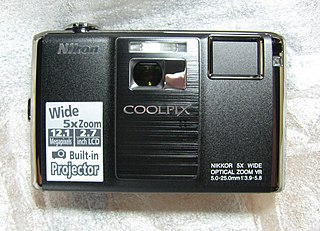 W
WA point-and-shoot camera, also known as a compact camera and sometimes abbreviated to P&S, is a still camera designed primarily for simple operation. Most use focus free lenses or autofocus for focusing, automatic systems for setting the exposure options, and have flash units built in.
 W
WThe Ami is a viewfinder camera made of plastic, produced during the communist era of Poland era by the Polish firm Warsaw Photo-Optical Works or WZFO. It was the successor to their Bakelite-cased Druh camera, which was popular with youth due to its simplicity. The Ami was also quite popular, although its availability was sometimes restricted due to production limits in the economy imposed by the government.
 W
WThe Canon ELPH series includes several popular compact point and shoot cameras built between 1996 and 2002.
 W
WThe Digital Q1 was a FUJIFILM digital camera model announced in 2003.
 W
WThe DxO ONE from DxO is a small camera that attaches to a tablet or smartphone. It was originally compatible with iPhone and iPad using the Lightning connector port, and more recently with some Android phones. It was introduced in June 2015. The DxO ONE has a 1-inch format, 20.2 megapixel image sensor—the same one that is found in the Sony Cyber-shot DSC-RX100—and an f/1.8 maximum-aperture lens and high-speed shutter. The ONE uses the attached mobile device as an electronic viewfinder for the camera, which does not have its own viewfinder.
 W
WThe Instamatic is a series of inexpensive, easy-to-load 126 and 110 cameras made by Kodak beginning in 1963. The Instamatic was immensely successful, introducing a generation to low-cost photography and spawning numerous imitators.
 W
WThe Kodak DX7590 is a now-discontinued point and shoot model of digital camera first introduced in November 2004, replacing the earlier DX6490. It was manufactured by Eastman Kodak as part of the Kodak EasyShare product line's DX series.
 W
WThe Kodak Starflash belongs to the Kodak Brownie Star- lineup of cameras made by the Eastman Kodak Company in the United States and France between 1957-1965 and sold for $8.50.
 W
WThe Konica C35 AF was the first mass-produced autofocus camera. it was first released in November 1977.
 W
WThe Leica X-U is a compact underwater camera by Leica Camera, released on 20 January 2016. The Leica X-U combines the APS-C format CMOS sensor of 16.5 megapixels with the Leica Summilux 23 mm f/1.7 ASPH lens. The camera records video in 1920 x 1080 or 1280 x 720 pixel resolution at 30 frames per second in MP4 video format. Made in Germany in collaboration with Audi Design, the Leica X-U has a aluminium top plate and an anti-slip TPE protective armor. The camera is fully waterproof at depths of up to 15 mm or 49 feet.
 W
WThe Nikon Coolpix S1000pj is a compact digital camera manufactured by Nikon released in September 2009 as part of the Nikon Coolpix series. The S1000pj is the world's first compact camera to feature a built-in projector.
 W
WOlympus C-350 Zoom is a 3.2 megapixel compact digital camera. The camera uses a 3.2 megapixel CCD sensor. It has 3x optical zoom lens but it can zoom up to 10x with digital zoom. As a storage media, it uses xD-Picture Card of capacity of 16 to 256 MB. As a power source it uses two AA batteries. The camera is also able to write video in resolution 160x120 and 320x240 at 15 fps in QuickTime MOV format. It was announced on March 2, 2003.
 W
WThe Olympus Stylus Epic, also known as the μ[mju:]-II in other parts of the world, is a 35mm compact camera. Introduced in 1997, the Olympus Stylus Epic followed a long line of fixed focal length, budget priced, consumer level, point and shoot cameras from Olympus that have tended to appeal to enthusiasts and professionals who want a camera small enough to fit in a pocket. It is much cheaper than most point and shoot cameras that are popular with enthusiasts.
 W
WThe Olympus Superzoom 120TC is a 35mm compact camera, most notable for being able to continuously shoot pictures at a rate of 4 frames per second. The 120 part of the model number represents the maximum telephoto focal length, the range being 35-120mm. The TC part indicates the it has a self-timer, and can be activated by an infra-red remote control. Another notable feature is that the zoom lens moves at 2 different speeds depending on how hard the button is depressed.
 W
WPanasonic Lumix DMC-TZ40 is a digital camera by Panasonic Lumix. The highest-resolution pictures it records is 18.1 megapixels. The camera Panasonic Lumix DMC-TZ40 is technically identical to the camera Panasonic Lumix DMC-TZ41.
 W
WPanasonic Lumix DMC-TZ60 is a digital camera by Panasonic Lumix. The highest-resolution pictures it records is 18.1 megapixels.
 W
WThe Samsung Galaxy Camera is a point-and-shoot camera which is an Android based mobile device. Samsung announced the camera in August 2012, with the slogan "Camera. Reborn." The device was officially released on 8 November 2012, with web sales beginning on 7 November.
 W
WThe Samsung Galaxy Camera 2 is a point-and-shoot camera which is an Android based mobile device. Announced at the 2014 Consumer Electronic Show in Las Vegas, Nevada, the Galaxy Camera 2 features Android 4.3 Jelly Bean, 1.6 GHz quad-core Exynos 4412 processor and 2GB RAM. The Galaxy Camera 2 is the successor to the Samsung Galaxy Camera. Unlike its predecessor, it has a GPS receiver.